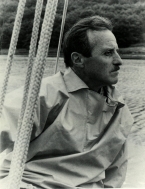
Biography of Charles Lapicque
Charles René Lapicque was born in 1898 in Theizé, in the Rhône, to Louis Edouard Lapicque, a professor of neurophysiology at the University of Paris, Sorbonne, and Marcelle de Heredia, an equally eminent neurophysiologist (they were professional partners as well as husband and wife). They encouraged their son’s education in both arts and sciences, both of which he pursued from an early age. He gained a degree in civil engineering at Lisieux in 1924 from which he developed a passion for geometrical working drawings and perspective. By the end of the First World War I, Lapicque had completed his scientific training but he continued to draw for his own pleasure and subsequently taught himself to paint. The relationship between the Lapicque family and the Paris scientific community was further strengthened when Lapicque married Aline Elise Thérèse Perrin, the daughter of the French atom scientist, Jean Perrin.
Intuitively Lapicque felt a far greater affinity for art than science and, from 1928, he studied and became expert in painting, printing techniques and sculpture. In 1931 he moved to Paris to work at the Faculté des Sciences and used its laboratory to develop his own ideas about the perceptions of colour in relation to pictorial creations. With a dissertation on Optics and the Perception of Contours he became a Doctor of Science in 1938.
Encouraged by the Cubist sculptor Jacques Lipchitz (Lithuanian, 1891-French, 1973), Lapicque decided to devote more of his time to painting. The results of his experiments, 'Essai sur L'Espace, L’Art et La Destinée', was first published in specialist reviews in 1939 and appeared in book form in 1958.
In this treatise he sought to define the philosophical appeal of different artistic styles and movements with reference to the optical discoveries each represented. This work had a profound influence on the artists participating in the 1941 Paris exhibition, Vingt Jeunes Peintres de Tradition Française (Twenty Young Painters in the French Tradition), at which Lepicque also exhibited, hence his reputation as a leading light of the New School of Paris, whose works determined the development of non-figurative painting between 1939-1943.
It is these complementary scientific and artistic activities that makes Lapicque unique in French painting. As a painter, colourist and theorist with an original and scholarly mind, he was oblivious of prevailing artistic trends and developed a style of his own which was characterised by its great freedom. Far from hampering his painting, his academic rigour seems only to have encouraged his audacity. Lapicque’s work is characterised by its great intensity, his use of sumptuous colours and dynamic composition, harmonised by balance and visual appeal.
During the 1930s Lapicque exhibited in the main Paris Salons and, in 1937, he was commissioned to execute five decorative panels for the Palais de la Découverte at the Paris Exposition Universelle (Universal Exhibition) which was dedicated to the sciences. He subsequently took a particular interest in Cubism, as a result of which his work approached that of the painter, stained glass designer and writer, Jean René Bazaine (French, 1904-2001) and the painter, textile designer and muralist, Maurice Estève (French, 1904-2001). Together they became known as Peintres de Tradition Française (Painters in the French Tradition) as distinct from the École de Paris.
His growing reputation was recognised at the end of the 1930s when he was taken on by Louis Carré, the celebrated Parisian art dealer and gallery owner who promoted and exhibited many of the Modern Masters, such as Juan Gris (Spanish, 1887-1927), Paul Klee (German/Swiss, 1879-1940), Henri Matisse (French, 1869-1954), Alexander Calder (American, 1898-1976), Joseph Fernand Henri Léger (French, 1881-1955), Robert Delaunay (French, 1885-1941), Frantisek Kupka (Czech, 1871-1957), Pablo Picasso (Spanish, 1881-1973) and Jaques Villon (French, 1875-1963), as well as Bazaine and Estève.
As he gained increasing success, he began drawing a number of series of subjects, such as figures, macabre dances, landscapes and the sea. His attraction to drawing was the spontaneity which the speed of the medium allowed and his technique served a determined intention to provide an energy, elegance and spontaneity that bordered on the compulsive.
Lapicque abandoned engineering in 1943 and devoted himself entirely to art for the rest of his life. He died at Orsay in 1988. His work has been exhibited at the Pompidou Centre and internationally and is to be seen in the Musée National d’Art Moderne in Paris and in many museums and galleries in France and internationally.
